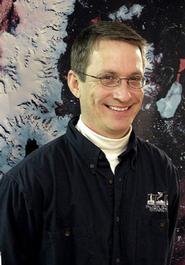
Eugene Domack, the J.W. Johnson Family Professor of Environmental Studies, gave an invited keynote talk at the 33rd Annual International Geological Congress meeting in Oslo, Norway, in August. His talk was titled "Chronologic Constraints on Deglaciation of the Antarctic Continental Shelf, A Review of Radiocarbon Methods and Applications." For nine days 6,000 scientists from 113 countries took part in lively discussions within almost every conceivable aspect of geology. The abstract text of Domack's talk follows.
Abstract Text
Recession of glacial ice along the periphery of the Antarctic Ice Sheet can be constrained by proper use of radiocarbon and physicalproperty measurements within the context of ice drainage reconstructions. Paleo flow line models are often neglected in the assemblyof sediment core stratigraphies and we illustrate how this is a first order requirement for understanding the timing of deglaciation from several sectors, including the Antarctic Peninsula, Ross Sea, and East Antarctic margin. Second order errors revolve around the assumptions made in the radiocarbon method and its use on varying carbon sources within sediment sequences. We address these errors in a systematic way beginning with assumptions about reservoir correction, reworking effects, and vital effects between different organisms. We present new methodologies which help to constrain the reworking influence on radiocarbon ages derived from organic matter, via examples from both the Weddell and Ross Seas. Proper stratigraphic context and sampling is also important in any chronologic model and we review both the errors and assumptions in this aspect of the problem. Our results confirm a general convergence on the timing of deglaciation from several sectors which post dates steps in eustatic sea level rise, most notably Meltwater Pulse 1A. We provide evidence that suggests why this is so from paleo flow line reconstructions as constrained by seafloor morphology.
Abstract Text
Recession of glacial ice along the periphery of the Antarctic Ice Sheet can be constrained by proper use of radiocarbon and physicalproperty measurements within the context of ice drainage reconstructions. Paleo flow line models are often neglected in the assemblyof sediment core stratigraphies and we illustrate how this is a first order requirement for understanding the timing of deglaciation from several sectors, including the Antarctic Peninsula, Ross Sea, and East Antarctic margin. Second order errors revolve around the assumptions made in the radiocarbon method and its use on varying carbon sources within sediment sequences. We address these errors in a systematic way beginning with assumptions about reservoir correction, reworking effects, and vital effects between different organisms. We present new methodologies which help to constrain the reworking influence on radiocarbon ages derived from organic matter, via examples from both the Weddell and Ross Seas. Proper stratigraphic context and sampling is also important in any chronologic model and we review both the errors and assumptions in this aspect of the problem. Our results confirm a general convergence on the timing of deglaciation from several sectors which post dates steps in eustatic sea level rise, most notably Meltwater Pulse 1A. We provide evidence that suggests why this is so from paleo flow line reconstructions as constrained by seafloor morphology.
Posted September 4, 2008
